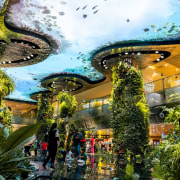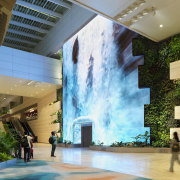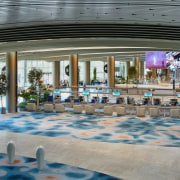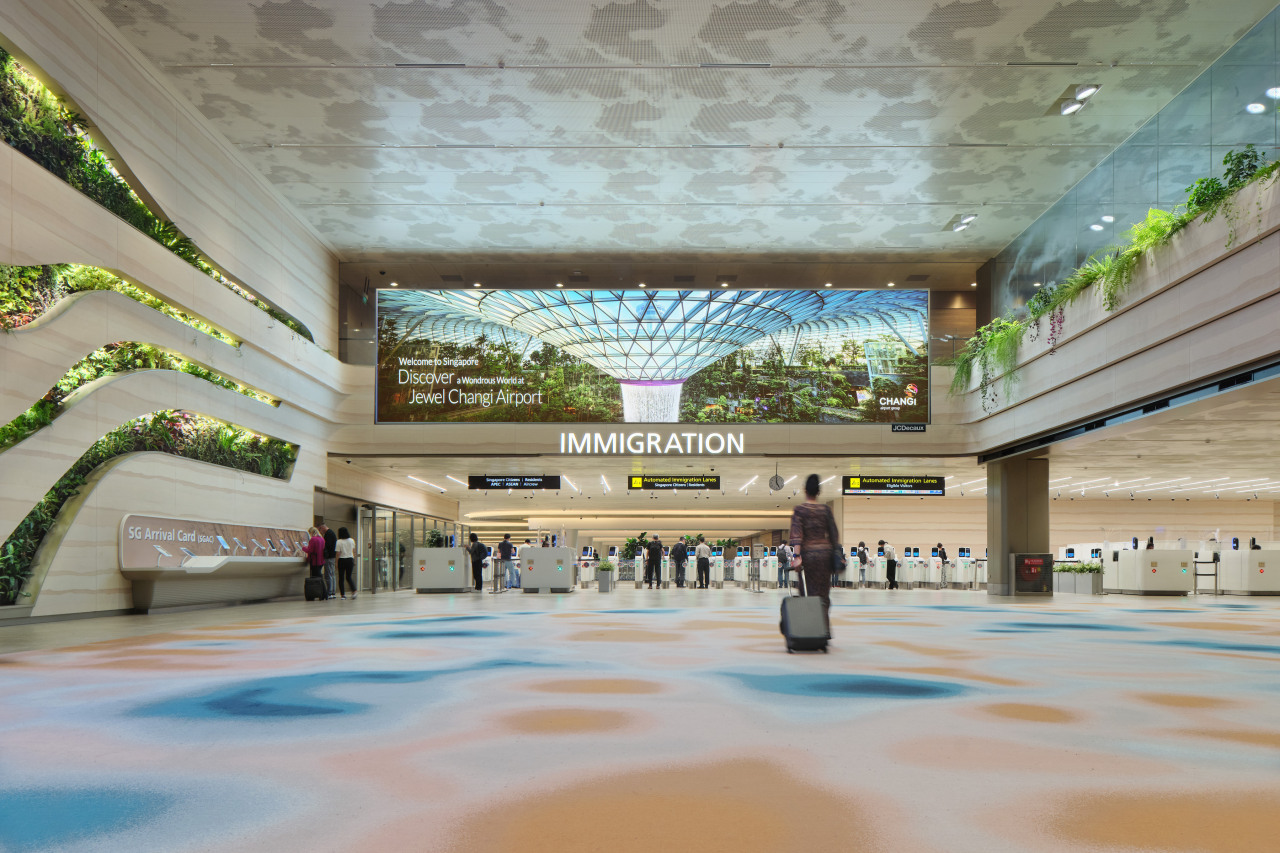Recapturing the romance
Flying used to be glamorous, you even dressed up for it – this nature-infused, de-stressing terminal, by Boiffils Architectures, again romances the flier experience
Designed by Boiffils Architectures
From the architects:
In a complete redesign of Terminal 2 at Singapore’s renowned Changi Airport, the Paris-based Boiffils Architectures has focused on traveller experiences and connections to the earth’s elements to provide a new 21st century gateway to the ‘Garden City’.
An innovative presentation
Recognised for finding solutions to complex problems, and for its familiarity with Asian culture and markets, Boifflis was able to bring significant artistic and cultural elements to the 5-year expansion project, comprising 120,000m² across three levels.
Our deliberate departure from the typical approach to most airport projects really caught the attention of the Changi Airport Group, says architect Basile Boiffils.
“Our proposal placed the priority on the traveller experience, rather than on the management of passenger flow.”
Originally built in the 1990s and renovated in 2003, at a time when efficiency prevailed, the Terminal now has a different focus – Boiffils Architectures has prioritised passenger pleasure and comfort through punctuations of visual, auditory, and interactive experiences.
The project spans three levels, including Arrival and Departure halls, and a mezzanine on Level 3 where food and beverage options are available.
The existing terminal architecture was rooted in the traditional airport focus on business efficiency, rather than comfort and pleasurable user experiences.
Boiffils Architectures’ idea was to romanticise the airport experience, infusing pleasurable experiences into increasingly stressful travel scenarios through a series of visual, audio, and interactive stimuli intended to soothe the mind, body, and soul.
Leveraging the company's extensive experience in shopping mall design, Boiffils Architectures has developed efficient circulation patterns and welcoming environments, which were critical components of their vision for the project.
Their experience in developing relationships of trust with clients also played a critical role, and the firm collaborated closely with Changi’s teams.
Through monthly presentations and constant requests for approval of materials and creative ideas, the working relationship evolved into a partnership of trust, with the client embracing the firm’s creative visions.
“Singapore is a model of perfection, and the Changi project management team was the most professional that we have worked with to date,” says architect Jacqueline Boiffils.
“Through constant dialogue, our pursuit of perfection harmonised with the expertise of the Changi team.”
A fluid gateway to the Garden City
As the first step in travel, airport experiences can be daunting.
Boiffils Architectures endeavoured to create a serene multi-sensory environment allowing passengers to enjoy the calming effects of nature.
The project was designed as a journey across an indoor landscape encompassing minerals, water features, and lush vegetation in various forms and densities.
“We wanted the architecture to be a source of emotions and a stimulant of senses through its connections with nature,” says Basile Boiffils. “As lovers of nature and gardens, we drew those inspirations from vegetation, topography, geology, minerals, ponds, streams, currents, water reflections, and much more to create spaces and forms that blur the boundaries between architecture and landscape.”
To humanise the airport experience and keep people connected, Boiffils Architectures treated the spaces with design philosophies reminiscent of luxurious hotel complexes, with a welcoming and personalised check-in experience.
Rich earth tones, noble materials, and high-tech elements were integrated into an environment traditionally defined by cold and sterile colours.
Upon arrival in the departure level, bright, colourful carpeting evokes aerial views of land and sea, with colourful and textured lines representing the sedimentary layers of the earth.
Vegetated columns extend from the ground floor, forming multiple atriums inspired by nature and its elements.
Borrowing from contemporary hotel hospitality, Boiffils Architectures has humanised the check-in process, making it quick and efficient.
The open floorplan positions each of the automated check-in kiosks and baggage drop belts as uniquely shaped and positioned islands, rather than as traditionally linear counters.
“The islands were designed as an alternative to the traditional frontal approach, and the idea was to make the hall as panoramic and open as possible, with smooth circulation,” says Basile Boiffils.
“Travel in the 21st century is filled with stressful moments – from check-in to security lines and immigration – and we wanted to provide extensive transparency to enable views of the steps ahead as a way of reducing anxiety derived from the unknown and unfamiliarity with the airport.”
Upon arrival in Terminal 2, travellers descend a set of escalators to a highly automated and streamlined immigration zone, where Boiffils Architectures has strived to conceal the technical and regulatory aspects.
Travellers are surrounded by an environment of vegetated walls and colourful carpeting, with continuous, organic lines facilitating transitions and offering clear forward views of adjoining steps in the journey as part of a shared architectural language.
Unobstructed views from the immigration zone through to the baggage carousels and ‘meet and greet’ area induce a calmer mindset, allowing travellers to get their bearings prior to moving forward.
An unprecedented challenge
Faced with a two-year closure of the terminal during COVID-19, the Singapore airport authorities were faced with a drastic decrease in revenue, leading to discussions of cost reduction measures with Boiffils Architectures.
However, the airport powers-at-be sought only cost-effective alternatives that could be implemented without sacrificing on quality and experience.
“One of the ways we addressed the issue was with the flooring of Level 1, after we had already completed the installation of a beautifully patterned stone floor on Level 2,” says Basile Boiffils.
“Rather than proceeding with the same process, we found a ceramic company that was able to masterfully replicate the colour and patterns of the stone at a lower cost.”
Between earth and sky
Looking up, Boiffils Architectures designed a complex ceiling structure in the Departure Hall to conceal a world of its own, where a network of essential catwalks provides access to a multitude of mechanical systems.
Developed through parametric design, the architects created an intricately baffled ceiling composed of aluminium blades, with each fin forming a double-curved configuration that arches and twists to fulfil its function.
“The ceiling is designed to conceal every little detail, including sprinklers, security cameras, and floor lights that are tucked between the baffles, almost unnoticeable to the eye,” says Jacqueline Boiffils.
“Most of the elements that we created are partially or completely invisible, which was a conscious effort on our part to remove the impression of an airport as being a cold and engineered space.”
The nearly invisible lighting, designed in collaboration with French lighting design consultant Ph A Concepteurs Lumière, combined with the choice of semi-polished flooring, infuses a far more soothing and serene vibe into the atmosphere than that experienced in traditional airports.
Accordingly, noise levels are noticeably lower.
And as a firm that has embraced nature in its DNA since its founding, Boiffils Architectures's additional lighting was designed to provide all of the necessary illumination required by indoor vegetation, all custom-designed according to the optimal requirements of each species to ensure long-term sustainability.
“Beyond just attempting to put forth an eco-friendly project, our focus was really on creating a calming environment for travellers,” says Basile Boiffils.
“And, in doing so, it has become a benchmark for this type of ecological design.”
A dialogue between technology and nature
Continuing with the aim of offering travellers new experiences, Boiffils Architectures has created two spaces where nature and technology are intimately intertwined, inviting multimedia studio Moment Factory to collaborate on the creations.
Travellers will have the opportunity to experience Singapore's flora through two unique immersive installations.
Leveraging advances in technology that would not have existed a decade ago, Boiffils Architectures has created a visual focus at the central axis of the Departure Hall in the form of a 14m-high digital waterfall display known as “The Wonderfall”.
Soothing cascades flow between vertical gardens rising on both sides of the curved LED screen, composed of three large flat segments to provide an optimal view.
Several times an hour, the tumultuous waters change direction on megaliths, creating a fascinating dance between the elements.
Set to music composed by Jean-Michel Blais, the choreography channels the raw energy of a torrent into moments of grandeur until gravity returns the water to its natural state.
“The entire project is a dialogue between technology and nature, but with the technology largely concealed to highlight the natural elements,” says Basile Boiffils.
“The technology provides comfort and efficiency, but the human focus is what defines the user experience.”
Collaboration with Moment Factory extended to a renovation of the south garden of the transit area, providing a restful respite for layover passengers disoriented by intercontinental travel.
To provide a sense of connection with the outdoors, where they are not permitted to go, the collaborators created an LED ceiling that replicates external weather conditions in real time, from overcast skies to sunrises and sunsets.
Additionally, every 30 minutes, a show features on the skylight screen – producing rain, accumulating water, spurring vegetation growth, and more.
On the floor, an acrylic edged platform gives the impression of walking on water, embraced by abstract mirrored steel walls and flowing water in an area collectively known as ‘Dreamscape’.
Throughout the garden, the tropical sounds of Singapore can be heard through bird songs, insect noises, and other local creatures, generated in real-time from a catalog of nearly 100 recordings and broadcast through an immersive 3D sound system.
Boiffils Architectures enlisted the contribution of Patrick Blanc, an artist botanist and inventor of the green wall, for the botanical sequences and plant selection.
Sustainability and humanity at its core
The project has been proudly rated Platinum for The Green Mark Certification Scheme.
The Green Mark certification is a green building rating system in Singapore designed to evaluate a building's environmental impact and performance.
It provides a comprehensive framework for assessing the overall environmental performance of new and existing buildings to promote sustainable design and best practices in construction and operations.
Platinum is the highest level of certification under the Green Mark Certification Scheme.
Buildings awarded the Platinum certification are industry leaders in environmental sustainability, showcasing exceptional and innovative practices in green building design, construction, and operations.
These buildings achieve the highest standards of environmental performance and are models of sustainability.
On the human side, another major contributor is Boiffils Architectures’ use of artisanal materials wherever possible to create very human scale experiences.
The firm is proud to have engaged craftsmen from very small firms to create many of the elements.
Colours were chosen for their soothing qualities, including champagne-coloured aluminium that envelops the main pillars of the terminal.
As a model of multinational collaboration, Boiffils Architectures worked closely with a Japanese contractor, and procured custom flooring made in Spain, organic counters and customised lighting from Italy, custom-designed stucco panels from France, blown glass chandeliers from Czechia, and the intricate ceiling structure made in China.
“The client was very pleased to have these elements custom-designed exclusively for their project,” says Jacqueline Boiffils.
“They particularly appreciated the tours of the artisan workshops we arranged for them, and this process became a very important aspect of strengthening our relationships.”
Credit list
Architect
Structural engineers
Lighting consultants
Landscape architects
Fire safety and risk engineering
Multimedia
Luggage handling system
Feature lighting
Interior wall coverings
Chairs
Contractors & builders
Engineers
Botanical design
Consultancy and cost management
IT consultant
Architectural software used
Manufacturer of counters and luggage backdrop
Natural stone floor coverings
Carpet designer
Sofas and armchairs
Helpful links
Windows and Doors
Cabinetry Hardware
Spas
Home Builder
Roofing
Heating
Flooring
Taps
Kitchen Design
Home Design
Designed by: Boiffils Architectures
Story by: Trendsideas
Photography by: Fabian Ong – Changi Airport Group
Home kitchen bathroom commercial design



















